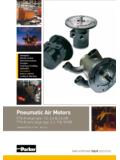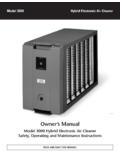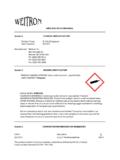Transcription of FINAL Residential Noise Control Guidance Sheet GK DRAFT
1 Residential Noise Control Guidance Sheet 6/29/16 Distributed by: New york city Department of Environmental Protection The following is intended to provide Guidance for residents of New york city seeking relief from city Noise . Residential Noise Control options, methods, products and services are described to aid homeowners and tenants living in multi-family dwellings (apartments, condos, etc.) and in single-family homes. Guidance is provided for Control of airborne, structure-borne, and heating, ventilation and air conditioning (HVAC) and outside Noise . In general, sound is a physical transfer of energy through the air in the form of fluctuating air pressure waves. Sound can be attenuated by avoiding, enclosing, deflecting or absorbing it. Noise Control measures can be applied at the source, along the pathway, or directly at the receiver. Specific Noise Control options and solutions should be carefully considered and implemented, otherwise it is very easy to fail in achieving the desired Noise reduction.
2 For these reasons, it is highly recommended that residents discuss their situation with a qualified acoustical consultant beforehand to ensure that only effective solutions will be considered before money is spent. Links to several national professional societies are provided below to aid in the selection of an acoustical consultant. This information is not an exhaustive list of Noise Control methods, products or vendors. It is intended for Guidance and informative purposes only, and should not be construed as an official endorsement of any product, vendor, or consultant by the city of New york . Any Noise Control or repair work done in Residential units will need to in compliance New york city s Laws, Codes and Rules, and permitting including but not limited to those of the Department of Buildings and the Fire Department. Check with your landlord or Co-op or condo board as necessary.
3 Acoustical Consultants Acoustical Society of America Institute of Noise Control Engineering National Council of Acoustical Consultants NYC Dept. Environmental Protection Residential Noise Control Methods Carpeting - Hardwood floors reflect and amplify reverberant Noise within a room, so installing carpet with thick padding is one effective method to reduce Residential Noise . Reverberant Noise is the additional Noise that exists after the original sound is made [echo effect]. Curtains - Draperies can have a significant effect for blocking or absorbing Noise . Heavy materials such as wools and velvet will have better result. Adding a vinyl-layer to existing curtains will enhance the soundproofing benefits as well. These curtains are commercially available for Noise abatement. Acoustic Panels Ceilings and walls can be lined with commercially-available acoustic panels that can absorb excess reverberant sound within the dwelling.
4 When selecting acoustic panels, look for the highest Noise Reduction Coefficient (NRC) rating available. NRC is a standard of measurement of Noise reduction of reverberant sound. The NRC ranges from 0 to 1, so look for panels with an NRC value of or greater. Bass Traps - Bass [sound] traps are foam shaped inserts that can absorb annoying low frequency Noise . They can also prevent sound sources, such as speakers, from being placed too close to the corners of the room where Noise is easily amplified by wall reflections. Flooring - Floor construction can help reduce Noise infiltrating into a residence. Resilient underlayment and dampening compounds can decouple [or insulate] the Noise pathway, while choosing materials that increase floor mass can further block Noise from transferring through it. This Noise often occurs with a bare floor. There are several resilient underlayment material available, including foam, fiber, cork, wood and rubber.
5 Finished flooring (hardwood, wood laminate, or tile) as a floating raft on top of underlayment can be effective for Noise insulation. The ability of a floor to block Noise can be quantified using the Impact Insulation Class (IIC) metric. IIC is the measurement of impact Noise insulation. It is generally recommended that floor construction should be at least IIC 50 for Residential living areas and at least IIC 60 for bedroom areas. Walls Wall construction plays a major role in how Noise transfers into a residence. To be effective, Residential walls should be made of heavy (massive) building materials, such as gypsum board, with an air gap of several inches between wall surfaces that s filled with sound absorbing material such as fiberglass thermal insulation. If possible, the two sides of the wall should be fastened to different studs so that there s no direct physical connection through the wall.
6 Providing additional studs also helps to stiffen the wall to reduce Noise . The ability of a wall to block Noise can be quantified using a measurement called the Sound Transmission Class (STC) metric. The STC is primarily intended to assess speech privacy between adjacent spaces, however its use has been expanded to serve as specification goals for any wall or barrier construction that blocks Noise . It is generally recommended that Residential interior walls should be at least STC 50, and exterior walls should be at least STC 60. The higher the STC the higher the mount of Noise will be blocked from entering the adjacent room. Windows and Doors - Most of the Noise that infiltrates a home from outdoors comes through the windows and doors. They are the acoustical weak link in the structure s facade. There are several options available to enhance the sound transmission loss capabilities of windows and doors.
7 Similar to walls, the STC rating of doors or windows is an indication of their ability to block Noise . It is generally recommended that Residential windows and doors should have a rating of at least STC 50. Replacement double- or triple-pane windows can be excellent Noise insulators. The same properties that make them effective thermal barriers also works for Noise reduction. Alternatively, the dwelling s existing windows can be left in place and an additional pane of glass or Plexiglas or acrylic panel can be installed either inside or outside the window (storm window). The greater the air gap between the panes of glass, the more Noise reduction can be expected from the window system. Solid wood core doors provide additional mass that will block sound much more effectively than hollow doors can do. Good quality rubber or vinyl gasketing should be applied around (and under if possible) all doors.
8 HVAC Equipment - HVAC [heating, ventilation and air conditioning] equipment involves rotating machinery and air moving devices which generate Noise and vibration that can propagate through the air and the structure to nearby spaces. HVAC Noise can be difficult to Control unless the true cause of the Noise can be identified. Residential HVAC Noise can be mitigated by (1) making sure the equipment is dynamically balanced and operating properly, (2) installing silencers in the duct line, (3) ensuring the duct line has no sharp turns or obstructions, (4) wrapping the ducts with acoustical lagging material for Noise absorption, (5) selecting low- Noise diffusers and grills, and (6) decoupling vibrating machinery from the structure with vibration isolator springs. White Noise for masking annoying Noise White Noise , or full spectrum random Noise , broadcast through small speakers can be an effective means of masking intrusive sounds and enhancing speech privacy.
9 White Noise does not reduce Noise within a space. On the contrary, it adds more Noise to the space to drown out unwanted sounds to make them less noticeable. Other methods that accomplish the same objective include the Noise produced by small fans or window unit air conditioners. Ideally, white Noise should be broadcast at a low and constant volume so that people are not aware it is being used. Music is a poor alternative. Example Products and Vendors The following provides contact information for finding Residential Noise and vibration Control products and vendors. Oftentimes vendors can provide knowledgeable recommendations for suitable products for a given situation; however an independent acoustical consultant should be able to provide more comprehensive Noise Control assessments and case-specific solutions. Ceiling/Floor and Wall Sound Isolation Products designed to mechanically isolate or add mass to walls and ceilings in order to increase acoustical isolation performance.
10 Acoustiblok Acoustiblok Curtains, Acoustiblok Wallcover AcoustiGuard GenieClip, Mass Loaded Vinyl, Barrier Material, Iso-sill Green Glue Noiseproofing Compound, Sealant, and Clip Kinetics Model ICC, KSCH, IsoGrid, IsoMax, PSB, KWSB, Wallmat, IPRB Mason Industries 30 and 30N Series, NPS, DNSB Wall Treatments and Duct Lagging Products designed to mount on interior walls and ceiling surfaces in order to absorb acoustic energy (note - only useful for reducing reverberant Noise ). Acoustiblok QuietFiber Acoustical Surfaces Wall Panel Eckel Industries Model EFP, FFP, ALP, DAP Industrial Acoustics Absorption Panels Pyrok, Inc. Acoustement Plaster Acoustical Doors and Windows Doors and windows specially designed for high acoustic performance. Acoustical Surfaces Noise Doors and Windows Krieger Specialty Products Acoustical and SCIF Doors and Windows Overly Door Company Acoustical Doors Vibration Isolators when vibration is a problem.













